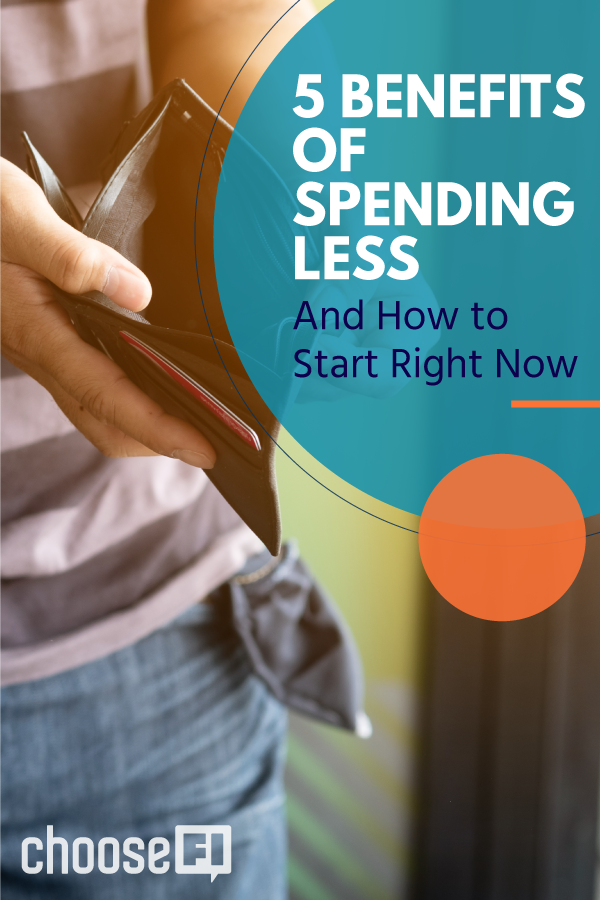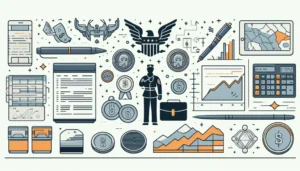When you get down to it, there are two ways to accumulate more wealth. One is by spending less money and the other is by earning more money.
We think that most people should consider starting with spending less. In a recent video, Jonathan outlined five benefits of spending less as your first step rather than trying to earn more money. As a bonus, he also highlighted five ways that you can start spending less right now.
The five benefits of spending less as the best way to start acquiring wealth are: you can do it immediately, the tax advantages of saving vs. earning, every dollar you do spend after saving goes further, more money means you can take a risk on bigger opportunities, and a greater appreciation for what you already have.Read on for more details on each of the five benefits of spending less and for the five ways you can cut down on your own spending right now.
Table Of Contents
- What Is A Gap And Why Do You Want To Increase It
- Five Benefits Of Spending Less
- Five Ways To Start Spending Less
- The Bottom Line
What Is A Gap And Why Do You Want To Increase It
Not to be confused with the retail store of the same name, a gap is what’s leftover after you subtract how much you spend from how much you earn. For example, if you earn $5,000 a month and spend $4,900 on expenses, your gap is $100.
A study done by The First National Bank of Omaha at the beginning of 2020 (prior to the pandemic starting) found that 49% of Americans were living paycheck to paycheck. That means they have no gap and no savings. The key to achieving Financial Independence is increasing that gap so that you have more money to save.
When you make immediate changes to your spending habits, you’ll start to see that gap increase right away. Later on, after you’ve changed your spending habits and become more of a saver, you can start to focus on earning more.
As Jonathan says in the video, “The ultimate luxury is not success, it’s freedom.” When you have saved enough money to be FI, you’ll learn just how much of a luxury the freedom from debt–and eventually employment–really can be.
Five Benefits Of Spending Less
Here are the five benefits of accumulating wealth by spending less that Jonathan discussed in his ChooseFI YouTube video.
You Can Start Spending Less Immediately–And See Immediate Results
When you make a lifestyle change, it’s much easier to stick to it if you see results right away. For a lot of us, the longer we have to wait, the less likely we are to stick with the change.
Spending less puts more money in your hands almost immediately. It shows you right away how beneficial spending less can be to your budget and to your savings.
Compare that to trying to earn more first instead of spending less. Side hustles have a lot of potential for bringing in money, but many require a lot of work and financial investment upfront. Then, after setup is complete, it could be several weeks if not longer before you’ll actually see the money.
When you see that comparison, starting to increase the gap by spending less is a no-brainer.
Related: How To Save $1,000 In 30 Days!
It’s Tax-Advantaged
If you earn more money, you also open yourself up to paying more taxes. That tax rate on your additional income could be 30% or higher.
Translated into real numbers, if you earn an extra $100, you may actually only bring home $70 after the taxes have been taken out. While an extra $70 is still great, we can all agree that getting the full $100 would be better.
If you focus on spending less instead of earning more, you keep the full amount that you saved. There are no taxes on it. For example, you can pay less to watch TV if you switch to a streaming service. So if you save $100 because you made that switch, you keep the full $100. That extra money can really add up as you start seeing more savings from your adjusted spending habits.
Every Dollar You Have Goes Further
According to Jonathan’s five reasons to start spending less, any money you free up by reducing your spending will be able to go further.
Think of it this way. Let’s say you make and spend $60,000 every year (meaning you have no gap) and decide to do some additional work to earn an extra $100 each month. That’s great but it doesn’t seem like much, kind of a drop in the bucket.
However, let’s say you make $60,000 and cut your spending down to $55,000. In this case, the benefit of spending less means you have an extra $5,000 a year, or about $416/month. Now add to that the extra $100 you’ve earned. Suddenly you’re able to save more than $500 each month. That $100 in earnings goes a lot further when you add it to the money that you’ve saved by spending less.
Spending Less Allows You To Transform Risk Into Opportunity
In the video, Jonathan calls your ability to keep your cost of living low a superpower. Once you have that power, your life can change in so many positive ways.
Let’s go back to our income example of $5,000 a month, which means you make $60,000 a year. If your cost-of-living expenses are $60,000 a year, then you have no gap. You’re spending every penny you bring in. The prospect of losing that income is really daunting because you know that you’ll have to replace the entire income to cover your expenses.
However, what if you were bringing in $60,000 and had a $10,000 gap? That means you had cut your cost-of-living expenses to $50,000 and were able to save $10,000 a year. The prospect of losing your income may still be daunting, but it’s a little less so because you know that you only need to replace $50,000 worth of income instead of $60,000. That might make your job search easier, especially in a challenging job market.
You should also ask yourself what you could do with that gap money. The answer is easy: a lot. The risks become lower and the opportunities greater when you have that $10,000 buffer in savings to fall back on.
One idea is to take that additional money and invest in setting up a passive income stream. In the video, Jonathan says that passive income is great but you often need to “frontload a crapload of work and money” before you see a profit. This extra gap money gives you the resources to do that. Another idea is finding a job that you love more but pays that less because you know that you really don’t need that much to cover your expenses.
Discover the framework for success from dozens of people who have found their own path to financial independence. Learn how to spend less, earn more, and live a fulfilling life of abundance. Download your free sample chapter today!
Choose FI: Your Blueprint to Financial Independence
When You Spend Less On Stuff, You Appreciate The Money You Do Spend More
The fifth benefit of spending less will give you a deeper appreciation of the money you do decide to spend. Jonathan references the concept of “hedonic adaptation” in his video. Simply put, hedonic adaptation is when we get used to a certain way of living.
For example, if you eat a good steak every night for dinner, you get accustomed to it and you’ll eventually stop enjoying and appreciating it. If this happens to all of the expenses in your life, you can see how your whole life can become one big hedonic adaptation.
When we spend less and only buy what we can really afford (that means without monthly payments and incurring huge debt buying stuff), the opposite happens. We appreciate what we have more. Over time, we will shift our mindset from loving the process of purchasing back to loving the actual item. In doing so, we will spend less and be grateful for what we have.
Five Ways To Spend Less
It’s not enough to know why it’s important to start spending less. You also need to know how to do it. Jonathan details five ways that you can immediately start cutting down on your spending.
Know How Much Your Life Actually Costs
Most of us have no idea how much our cost of living really is. Jonathan talks about learning what your “burn rate” is, how much you spend on a monthly basis. To figure that out, you need to know what your recurring and discretionary purchases are. Make a list of those expenses. Then ask yourself what can be cut? What is essential?
If you don’t already have a one, here’s how to create a budget. Track your spending and figure out where all of your money goes. Once you know your burn rate, you can set your budget and figure out ways to trim off the excess.
Listen: Do You Need A Budget? | YNAB
Do A No-Spend Challenge
Can you live for a day without spending money? Most of us probably could. But what about a week? Or a whole month?
We invite you to try this challenge. You might be surprised at far you could go. It’s a fun game, but it will also teach you just how much you can do with what you already have in your home.
Taking the challenge might be the best way to stop falling victim to the hedonic adaptation and reset your brain to appreciate what you have. It also will help you quickly see the benefits of spending less (or in this case, nothing) as you watch the money in your checking account stay steady rather than decreasing.
Related: Fantastic Ways To Destress Without Spending Money
Understand Where Your Spending Black Holes Are
All of us have places where we spend way more money than we probably should. These are places where money just seems to disappear. For some, that black hole is the local coffee shop where we buy our morning latte. For others, maybe it’s car accessories or clothes.
Jonathan highlights that for a lot of us, our grocery budget is our black hole. We can easily drop a lot of money on a weekly basis and have no idea what we’re really buying. Jonathan and Brad suggest a metric of $2/person/meal to set for your grocery budget. So $2/meal multiplied by three meals a day equals $6/person/day. That’s $180/person for the month. Therefore if you are married and have two kids, that’s $720 a month for your family grocery budget.
If that’s way below what you’re spending now and it seems like too low of a target to hit, set a limit you’re more comfortable with. However, set the goal of slowly decreasing your spending until you’re as close to the $2/person/meal mark as possible.
Pay Off High-Interest Debt
Most of us have fallen into the trap of overspending and putting too much on our credit cards. Those credit cards, in turn, charge a huge amount of interest if we can’t pay off our bill in total each month.
In order to start spending less overall, you need to spend the money you do have to pay down the high-interest debt that you have on your current loans. That might include credit cards, student loans, car loans, etc. That debt is keeping your gap from increasing. Once you get rid of the high-interest debt, that money that you’ve been giving to those agencies can go back into your overall budget.
The key for this piece is to remember not to go back into the cycle of high-interest debt once you’re done paying off your current debt. Buy only what you can afford to pay for in cash and you’ll avoid this particular black hole.
Explore Refinancing For Current Loans
Interest rates are very low right now. It’s a good time to refinance current loans like your mortgage or home equity loans. Depending on when you initiated your loan, you may be able to take several percentage points of interest off of your current fee structure.
One caution with this is that there is usually a fee to refinance. Make sure you ask about what that is and that you have enough to cover it. Sometimes the fee isn’t worth the refinancing, so do the math before you commit to the refinance.
Listen: Should I Refinance My Mortgage?
The Bottom Line
The benefits of spending less become evident once you see them laid out. They can make an impact on your budget right away and help you to understand why having more money to save is so important. If you have other ways to start saving immediately, we’d love to hear them. Share in the comments below!
Related Articles




